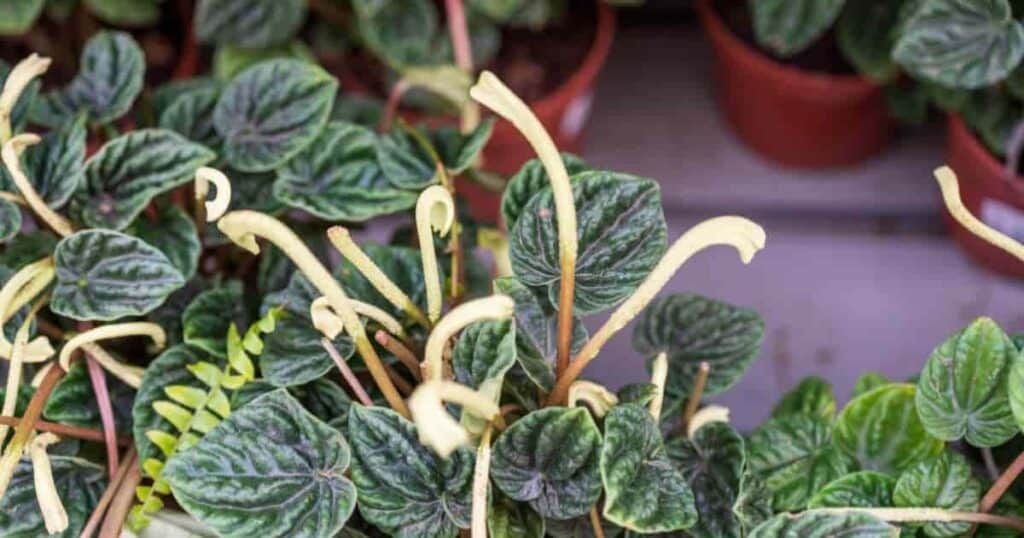With over 1,000+ varieties of Peperomia with a common name, the radiator plant includes popular houseplants like Watermelon Peperomia, Ripple Peperomia, Baby Rubber Plant, and others.

You have likely come across them in nurseries offering houseplants. Whatever Peperomia variety you own, your glossy-leaved plant may develop long spikes.
Are these peperomia flower spikes? Yes, read on to learn what to do about them.
Do Peperomias Flower?
All Pepermonia plants flower, but they don’t flower until they are mature. Most species in the Peperomia genus bloom in the summer, and the pepperomia flower last for about two weeks.
Peperomias usually only bloom when the plant is placed under low light or bright indirect sunlight and enjoys good watering and fertilizer.
Avoid overwatering; this plant is prone to root rot problems when not placed in a pot with enough drainage holes. This will make sure excess water is removed from the plant.

You can consider buying a humidifier to increase moisture levels because many Peperomia thrive in environments of high humidity.
Peperomia obtusifolia flowers are not the most attractive, and most plant lovers do not purchase plants for their flowers. The green foliage of Peperomia obtusifolia is the usual showstopper.
Having an area dedicated to the peperomia bloom is not a bad idea. Start with propagation through stem or leaf cuttings.

For stem cuttings, take a stem from the plant and trim away the lower leaves, leaving one or two mature leaves at the top.
Make sure there’s at least one node on the stem that you can insert into the soil.
What Do The Peperomia Spikes and Blooms Look Like?
The Watermelon peperomia flower doesn’t have any special features, and it doesn’t resemble a flower. The flower stalks, also known as spikes, have two little stamens and pistils.
You know your peperomia is blooming if you see spikes or inflorescences on the plant.

Baby rubber plant flower spikes are almost 3″ inches long and white, brown, or green in color. The spikes look like tails growing from your plant. The tiny blooms appear on the spikes with no particular fragrance or scent and are non-toxic to humans and pets.
The spikes will fall off in about two weeks on their own once blooming is over.
Peperomia flowers produce a thin, coated berry.
What Can I Do About Spikes On My Peperomia Plant?
If you have a Peperomia plant and suddenly notice tail-like spikes growing from it after a few years, don’t worry!
These spikes are caused by peperomia flowering in action, and the fact that you’re seeing them means that you have provided the plant with adequate care and water.

Pinch Them Off
While the spikes will fall off on their own, some people choose to pinch these blooms off as they are not particularly visually appealing.
Let Them Fall Off
However, there is no need to cut them off, as the Peperomia spikes aren’t impacting the plant’s resources.
Once the hard work of growing the spikes is done, the plant is perfectly happy until the spikes fall off naturally.
However, if the spikes’ appearance bothers you, you can pinch them off. Some gardeners find that removing the plant’s spikes helps it put energy into new leaves.
With so many different peperomia species there is a wide range of physical characteristics.

The shape of the leaves varies between heart, oval, or lance-shaped leaves. In addition, the color and appearance can be striped, marbled, smooth, or rippled.
No matter which Peperomia plant you purchase, it will produce watermelon peperomia flower spike with proper care.
While this may seem unconventional if you’re a first-time Peperomia plant owner, you’ll get much more enjoyment from the plant’s beautiful and unique leaves.
More on Peperomia Plant Care
- Saving Overwatered Peperomias – Learn how to save your overwatered peperomia plant and how to prevent it.
- Learn about String of Turtles plant care to maintain its beautiful appearance.
